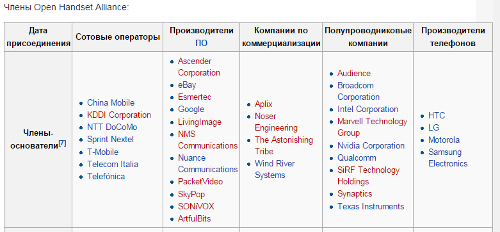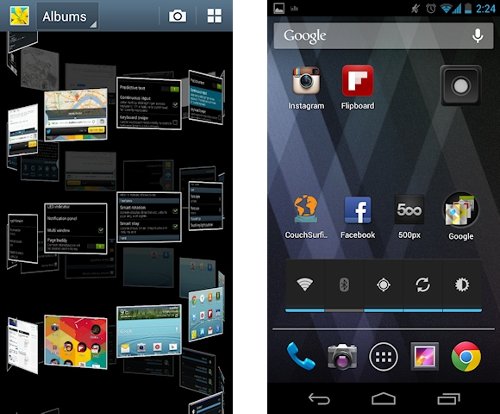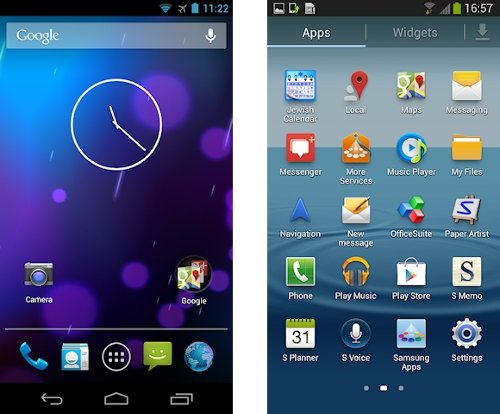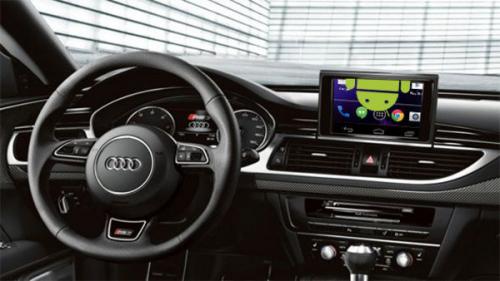For the mobile industry September 23, 2008 can be considered a historical date. On this day officially released the first version of the operating system Android. Then to the “Green Robot” with delicious names many versions were skeptical. However, time will put everything in its place, and mobile operating systems, once dominated the smartphone market, are gone.

However, the history of the Android operating system launched a little earlier. In July 2005, Google acquired Android Inc. At the time of the transaction on the existence of Android Inc, and what she did know a few. Andy Rubin (Andy Rubin), Rich Miner (Rich Miner), Nick Sears (Nick Sears) and Chris White (Chris White) worked on the project quite secretive. Their goal was to create a mobile operating system, which is due to a variety of services and use of geolocation data may need to adjust to the users. However, as an independent developer Android Inc did not last long. Starting work on a project of its own operating system in 2003, by 2005 the creators of Android Inc have not been able to attract the right amount of independent investment and conversion of the company into “daughter» Google was the only option the company’s survival. After absorption Android Inc Andy Rubin continued to work on Android and Google left only 2014, decided to create their own & #8220;incubator start-ups” in the field of robotics.

The next important step in the formation of the Android operating system was the creation of Open Handset Alliance, whose birthday was November 5, 2007. In addition to Google’s Open Handset Alliance originally included 34 companies, among which were the manufacturers of mobile devices software developers and manufacturers of “iron”. Along with the announcement of the Open Handset Alliance, Google announced plans to release an open platform for mobile phones based on the kernel Linux. The first release of a set of developer held on 12 November, 2007. To generate interest in the new Google mobile platform organized Android Developer Challenge, a contest for developers with a prize fund of $ 5 million.


The first version of Android was named «Apple Pie» («apple pie”, an early name «Astroboy») and, as mentioned, was released on September 23, 2008. The main features of Android began to fall from the top notification bar, widgets on the home screen, integration with services Google (mail, contacts, calendar, maps) and its own application store.

The first smartphone running the operating system from Google has become the HTC G1 (HTC Dream) was released at the mobile operator T-Mobile. By the standards of this smartphone was unusual, both in form factor, and in terms of specifications. In particular, he received a hardware keyboard, 3.2-inch touch screen display resolution of 320×480 pixels, 192 MB RAM, 528 MHz processor Qualcomm MSM 7201A (by the standards – a very fast processor), as well as 3.2 megapixel rear camera, card slot microSD memory and a set of wireless interfaces, including Wi-Fi, 3G, GPS. Battery capacity HTC G1 was 1150 mAh.

The first version of the operating system from Google is already too “raw” and caused a lot of complaints from users. Some of her only as “beta” is not called. On the other hand – the most “advanced” saw Android and integration with Google services huge potential and become true fans of the OS. At the same time began to oppose Android iOS.

However, errors and limitations of the work function is normal for products that are just beginning their life cycle. And Android is no exception. Especially that February 9 2009, the operating system is updated to version 1.1 «Banana Bread» («Banana bread”, an early name «Bender»), where there were a number of errors corrected, amended in the API, and also produced a number of other changes. In particular there was an automatic software updates. But the main purpose of Android 1.1 was just fixing bugs of the first version.

In fact Android has become a serious update released April 30, 2009 Version 1.5« Cupcake “(” cake “), which brought many innovations. In particular «Cupcake» got a virtual keyboard with function software filling, advanced features for working with video, support for direct delivery videos on YouTube and photos on Picassa, enhanced support for Bluetooth (including the profile A2DP) and a number of other improvements. In fact, it is this version of the OS from Google is the first that is suitable for practical use.

And the range of” guglofonov “began to expand. Smartphones with Android on board presented Samsung, HTC, Motorola and other manufacturers. Moreover, Chinese companies it became Android 1.5 software platform for the first experiments with cheap smartphones are gradually gaining popularity of mobile OS. Moreover, in the sale of “Chinese” with Android 1.5 is not uncommon, even after the following versions of the operating system from Google.

HTC Magic – HTC G1 version without the QWERTY-keyboard

September 15, 2009 Android updated to version Android 1.6« Donut »(« donut “). For the line of Android 1.x “donut” was the last update. As well as for many devices that came with Android 1.5 on board. Donut list of improvements included a step by step navigation from Google (not available in all markets), an updated Android Market, an improved interface photo and video cameras, modifed “Gallery”, advanced search capabilities (including voice) and screens support higher resolution (WVGA ). In addition, the update to Android 1.6 was the final for the first Android-smartphone HTC G1. Unless, of course, talking about the official updates.

However, the purpose of issuing «Donut» was to bring a smartphone with Android first generation to a “final status” and forget about them. Especially that in October 2009, were announced Motorola Droid and Android 2.0 «Eclair» («Eclair”). Relatively Android 1.x, output Android 2.0 is a big step forward. Has undergone a major revision OS user interface – have been updated desktop, browser, contacts lists, virtual keyboard and other elements. In addition, there were “live wallpaper”, support for Microsoft Exchange Server, HTML5, digital zoom, flash support and a number of other innovations.

However, Android 2.0 was enough” raw “version of the OS that was” exclusive “for one device Motorola Droid. However, this issue is more important than Google had to declare itself by presenting a worthy competitor for the iPhone. And they succeeded: the novelty has a 3.7-inch screen resolution of 480×854 points, 5 megapixel camera with autofocus, QWERTY-keyboard, 512 MB RAM, a slot for memory cards, a set of Wi-Fi / Bluetooth / GPS and battery capacity of 1400 mAh . Incidentally, the thickness of the lateral slider only 14 mm. The only pity is that the Motorola Droid only supports CDMA network, and was addressed to subscribers of Verizon.

The next version of Android – 2.1 retained the name« Eclair » but became much more popular. Of the innovations Android 2.1 include support for multiple accounts Google, the emergence of HTML 5 in the embedded browser, a number of other evolutionary changes, as well as bug fixes and “roughness» Android 2.0.
Along with the release of Android 2.1 saw the light of the new ” guglofon »- Google Nexus One, G1 as created by HTC. By the standards of Nexus One was very interesting – 1 GHz processor Qualcomm Snapdragon (QSD 8250), 512 MB of RAM, the same amount of internal memory and a 3.7-inch display resolution of 480×800 pixels. Of course, now that assembly of characteristics seem overly modest, but then it was a step forward – the typical Android-smartphone that time were equipped with 600 MHz processor and 256 MB of internal memory. Also of smartphones that time it should be noted HTC Desire and Samsung Galaxy S.

The next important date for Android was the release of version 2.2« Froyo “(” Frozen Yogurt “), the main novelty of which was the ability to install applications not only to the internal memory, but also on the card microSD. Given the very limited amount of internal memory of smartphones that time – a very topical feature. Android 2.2 also appeared voice dialing and exchange contacts via Bluetooth, the ability to lock the data using the cellular network, support for Adobe Flash 10.2 support and work as a WiFi-router. In addition, the engine has been updated JavaScript, client Android Market, enhanced support for Microsoft Exchange, there was quick switch between multiple keyboard layouts and their respective vocabularies, as well as a number of other nice improvements.

Compared with all previous versions of the OS,« Froyo »became the most massive versions of Android, as it is with Android 1.5 have moved many Chinese manufacturers who began to actively explore the market of Android-smartphone. However, over time, become even more widespread Android 2.3 «Gingerbread» («Gingerbread”), based smartphones that continues to go before the start of 2013. And despite the fact that the operating system was presented on December 6, 2010. By the way, according to the December 1, 2014 running Android 2.3 Gingerbread running for 9% Android-smartphone.

From the innovations Android 2.3« Gingerbread »can be noted cosmetic upgrade interface, support for high-resolution screens, a number of improvements associated with the sound, the appearance of support for NFC and an increase in the number of supported sensors that support the” Copy ” / “Paste” at the level of the operating system, as well as a number of internal innovations, such as power management and application control.

The next significant update Android is the emergence of Android 3.0 «Honeycomb» («Honeycomb”), based on tablet computers. Of course, tablets based on Android 2.x on the market also present, but they are not earned popularity. However, Android 3.0 «Honeycomb» and did not leave any significant trace – this version of the OS was presented February 22, 2011, and for 19 October of the same year saw the light of Android 4.0 «Ice Cream Sandwich» («Waffle Ice Cream”), again united smartphones and tablets in one software platform.

The list of innovations «Ice Cream Sandwich» is extensive, ranging from the return to a single shell for smartphones and tablets, improved multitasking, control Internet traffic , support functions by taking screenshots of the operating system and advanced security features, and the last major update interface, including the ability to complete failure of the hardware keys. Actually it «Ice Cream Sandwich» and the corresponding “iron” from Chinese manufacturers and became the starting point for the emergence of low-cost tablet PCs. Moreover, such devices are commercially appeared in early 2012, making plates in a mass product, which quickly began to improve.

Useful link:
Next sweet name – «Jelly Bean» («Jelly candy”) survived three versions of the operating system – 4.1, 4.2 and 4.3.

Of course, each of these versions had their own set of new features and bug fixes. But, it was an evolutionary development, during which gradually improved interface and new features. For example, in the Android 4.2 technology added Miracast and widgets on the lock screen and a standard tablet interface, familiar to many for Android 3.x and 4.0 – was deleted. From the family «Jelly Bean» most massive version of Android 4.2 began. The announcement of Android 4.1 on June 27, 2012, version 4.2 was presented October 29, 2012, and 4.3 – July 24, 2013.

Android 4.1
Along with Android 4.1 was presented to the Tablet PC ASUS Nexus 7.


Android 4.2
By the way, with Android 4.2 was able to declare itself loudly company LG, which released a very successful smartphone Nexus 4. I recall, it is a machine c 4.7-inch IPS + display resolution of 1280×768 pixels protected glass Gorilla Glass, 4-core 1.5 GHz processor family Qualcomm Snapdragon S4 Pro, 2GB of RAM, 8/16 GB internal memory, 8 megapixel camera on the back, 1.3 megapixel front camera, support for HSPA +, NFC and wireless charging. Battery capacity 2100 mAh. Price at the time of release – $ 299, and in August 2013 it dropped to $ 199

The announcement of the next generation of Android held 31 October 2013. Fresh OS version 4.4 and got an index name «Kitkat». Compared with the «Jelly Bean» changes in «KitKat» was made quite a lot, both external and internal. Moreover, one of the new features are support budget devices with 512MB of RAM and is constantly active voice assistant Google Now, which responds to the phrase «Ok Google». Another innovation pleasant Android 4.4 – the emergence of priority in the address book.

Interestingly, Android 4.4 has become a mass phenomenon in smartphones in the second half of 2014, and the latest version of Android 4.4.h lineup was announced on June 20, just days before it was introduced Android 5.0 «Lollipop» (or rather, addressed developers Android L). Also in 2014 were presented aimed at wearable accessories Android Wear, version for Android Auto Car and version for TV Android TV. Thus, the best positioning of the operating system from Google has become even wider. Another interesting point – launching initiatives Android One, in which smartphones will have a unified set of functions, depending on the market and positioning devices.

The official announcement of Android 5.0 «Lollilpop» was held October 15, 2014. Of the main innovations can be noted «Material design» (interface that provides a smoother operation of the device and adding new visual effects), designed to optimize energy consumption «Project Volta», the function «Android Smart Lock» and tighter integration with devices running under Android Wear / Auto. Special attention deserves a guest appearance mode, allowing the device to transfer to another person, pre-closing access to personal information. From the technical nuances not to mention the appearance of the 64-bit processors and replacing the compiler Dalvik on ART.
No comments:
Post a Comment